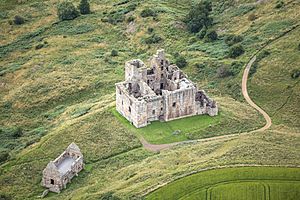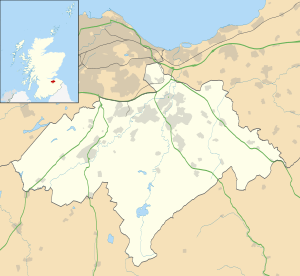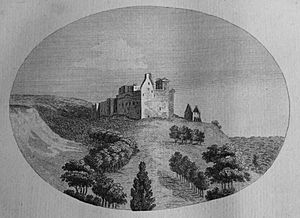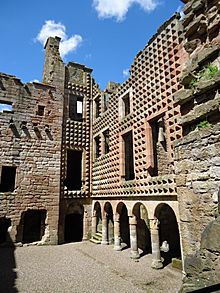Crichton Castle facts for kids
Quick facts for kids Crichton Castle |
|
|---|---|
| Crichton, Midlothian, Scotland UK |
|

Aerial view of Crichton Castle and stables
|
|
| Coordinates | 55°50′28″N 2°59′22″W / 55.8411°N 2.9895°W |
| Type | Tower house and courtyard |
| Site information | |
| Owner | Historic Environment Scotland |
| Controlled by | Crichton family Earl of Bothwell |
| Open to the public |
Yes |
| Condition | Ruined |
| Site history | |
| Built | Late 14th century |
| Built by | John de Crichton (d.1406) |
Crichton Castle is an old, ruined castle in Midlothian, Scotland. It stands near the village of Crichton. You can find it about 2 miles (3.2 km) south of Pathhead and east of Gorebridge, right at the start of the River Tyne.
This castle began as a simple tower house in the late 1300s. It grew bigger as the Crichton family became more powerful. Later, the Crichtons lost their influence, and the castle went to the Earls of Bothwell. In the 1580s, Francis Stewart, the 5th Earl of Bothwell, added a fancy new part with a unique diamond pattern. After some trouble, the castle was left to fall apart. Today, Historic Environment Scotland looks after the ruins, and you can visit them. Not far away is Borthwick Castle, a 15th-century tower house that is still in use.
Contents
History of Crichton Castle
Who Built Crichton Castle?
In the late 1300s, a man named John de Crichton built a tower house here. This was his family home. His son, William, became a very important person. He was the Lord Chancellor of Scotland and was made Lord Crichton around 1443.
In 1440, William Crichton was involved in a sad event known as the "Black Dinner." During this event, the young William Douglas, 6th Earl of Douglas, was killed. Because of this, William Crichton gained control of Bothwell Castle. In 1445, a group led by John of Corstorphine attacked and damaged Crichton Castle to get revenge. But William rebuilt and made the castle even bigger. He also built a church nearby.
Changes in Ownership
The 3rd Lord Crichton supported Alexander Stewart, Duke of Albany. In 1483, he lost his lands and titles because Albany was found guilty of treason. Crichton Castle, along with Bothwell Castle, was then briefly given to Sir John Ramsey. But he lost it in 1488.
That same year, King James IV gave Crichton Castle to Patrick Hepburn. Patrick later became the Earl of Bothwell. His son, Adam, died in a big battle called the Battle of Flodden in 1513. The castle then belonged to his wife, Agnes Stewart. She later married Lord Home.
Her son, Patrick Hepburn, 3rd Earl of Bothwell, inherited the castle. He sometimes worked with the English against the Scottish crown. But he eventually made peace with Mary of Guise, who was ruling Scotland at the time.
Mary, Queen of Scots, and the Bothwells
James Hepburn, 4th Earl of Bothwell, sided with Mary of Guise during the Scottish Reformation. When he took money sent by the English, Regent Arran ordered an attack on Crichton Castle. The castle was surrounded and captured by the Earl of Arran on November 3, 1560.
On January 4, 1562, a wedding took place at the castle. Patrick's daughter, Jean, married John Stewart. John was the son of King James V. Mary, Queen of Scots, who was John Stewart's half-sister, stayed at the castle for a few nights for this wedding.
In February 1567, the Earl of Bothwell was linked to the death of Queen Mary's husband, Henry Stuart, Lord Darnley. Bothwell then became Mary's third husband in May of that year. But in December, Bothwell lost all his titles and lands, including Crichton Castle.
Later Years and Modern Day
In 1568, Crichton Castle was given to Francis Stewart. He was the son of John Stewart and Jean Hepburn, making him King James V's grandson. Francis became Earl of Bothwell in 1577. He traveled in Europe and designed the very modern Italian-style part of the castle in the 1580s.
King James VI visited Crichton Castle in 1587. However, Francis Bothwell later lost the king's favor. He was accused of witchcraft and lost his lands in 1592. He had to leave Scotland and died in Naples. His son, also named Francis Stewart, got the castle back. But he had many debts from his father. He sold Crichton Castle to the Hepburns of Humbie.
The famous artist J. M. W. Turner painted the castle. It also appears in Sir Walter Scott's poem Marmion. In 1956, the castle was given to the state by its owner, Major Henry Callander. Today, Historic Environment Scotland cares for it. Crichton Castle was also used as a filming location for the movies Rob Roy (1995) and The Wicker Tree (2011).
What Does Crichton Castle Look Like?
Crichton Castle is made up of four buildings that are connected around a central courtyard.
The Oldest Parts
The oldest part is the 14th-century tower on the east side. It has a basement with a curved ceiling and a hall above it. Part of this tower has fallen down. To the west of this tower was a barmkin, which is a defensive wall.
William Crichton made the castle bigger in the early 1400s. He built a second tower to the south. This made the castle shaped like an "L," with the main gate between the two towers. The south tower had an entrance in the middle and vaulted cellars on each side. There were two halls on the first and second floors.
Later Additions
In the late 1400s, a west block was added. This included a six-story tower at the southwest corner. It had several bedrooms, each with its own private toilet (called a garderobe). A staircase in the south block led to these rooms. The north section was also added, closing off the courtyard. But this part was rebuilt a lot later on.
The Famous Diamond Wall
The most special part of the castle is its Italian-style courtyard wall. This is part of the north section. Francis Stewart, who designed it, had traveled to Italy. He was inspired by new building styles there, especially the Palazzo dei Diamanti in Ferrara. This is where he got the idea for the "diamond rustication" on the courtyard wall. This means the stones are cut to look like diamonds sticking out.
You can see the initials of Francis and his wife, Margaret Douglas, on the walls. There's also an anchor, which shows that Stewart was the Lord High Admiral of Scotland. Inside, there are other new features. The castle has Scotland's first "scale-and-platt" stair. This is a modern-style staircase with flat landings, not just a spiral. There's also a special drawing room north of the old tower.
South of the castle, there's a large building that used to be stables. It has a horseshoe-shaped window and rooms above for people to stay in.
Images for kids





